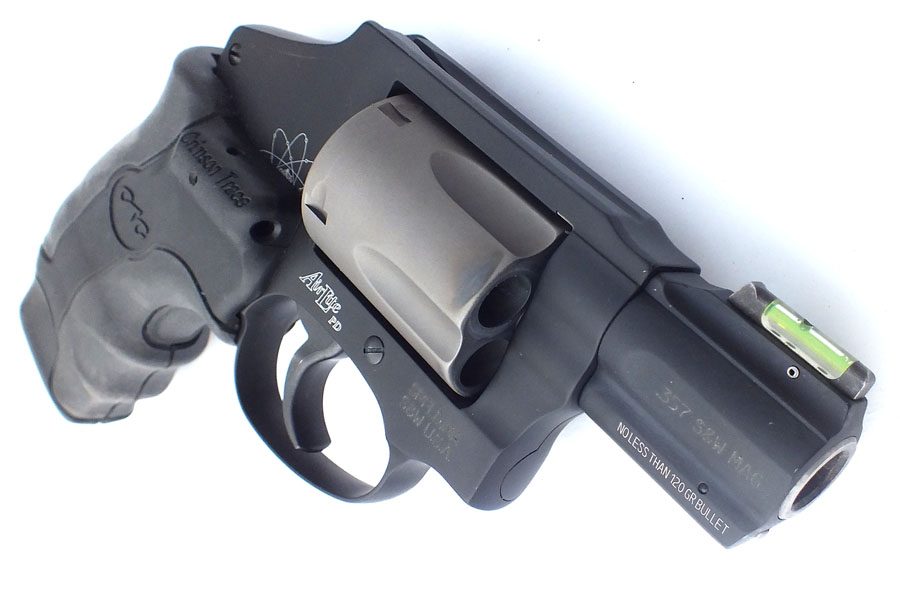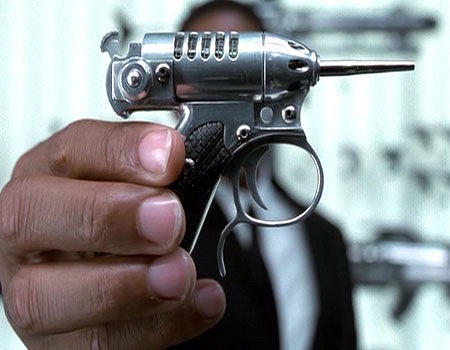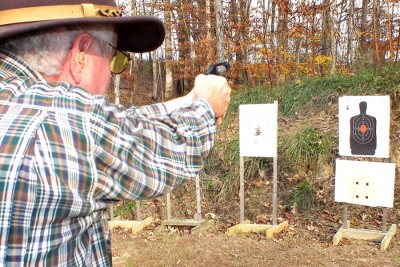[full_width]
[/full_width]
Buy one on GunsAmerica: https://www.gunsamerica.com/Search.aspx?T=340pd
The Ultimate CCH Package?
As long as men have carried weapons and as long as men will carry weapons, the argument will continue: Which is the best weapon to carry? I can imagine hairy men wearing animal skins arguing around the campfire which kind of sharpened stick or rock worked best. Some day in the future, strange beings with large heads and eyes will still continue to argue.
In the movie, Men in Black, I saw my personal choice in futuristic weapons. Will Smith’s character was issued a tiny little pistol that generated recoil that pushed him across the room, but delivered a devastating blow that would have taken out a tank. OK, I really don’t relish that kind of recoil, but I really do value a small, powerful handgun.
Today, no matter what is written, someone will come up with a way to debunk it. If it’s controversial, there will be endless threads typed out by experts who proclaim a superior knowledge of the subject and declare the writer to be a crack-pot. I will declare myself a crack-pot in advance, so don’t waste your keystrokes on me. I’m not a Navy Seal, retired Special Forces, Agent Orange Countersniper…. I’m just a guy who’s spent his life shooting.
In the process of building a book on the subject of concealed carry handguns, I did exhaustive research. I admit I have prejudices that were established in my psyche a long time ago, and therefore what I write here is my opinion and you can agree or not. Still, what I learned changed my perceptions about a lot of things. Here are some of the highlights:
- Most encounters where civilians defend themselves involved a low round count.
- Most encounters that involved a high round count did so because the gun held a lot of rounds and was fired until it was empty.
- Civilians who use a firearm in a defensive situation often have little or no training.
- In the overwhelming majority of successful civilian firearms defense situations, no shots are fired.
- The distance of recorded defensive encounters averaged less than three yards.
- Longer range events generally involved shots fired from within the home of the defender and many of these involved rifles and shotguns.
- 70% of defensive encounters happened in low light situations.
- More powerful rounds tend to be more effective at stopping an assailant, but not more effective at killing him.
- I confimred by questionnaire and asking individuals something that appears obvious: those who carry small guns are much more likely to carry them all the time.
- The features that make a handgun suitable for law enforcement and police don’t automatically make that handgun suitable for civilian defensive carry. A “typical” defensive scenario is drastically different from the range of experiences faced by law enforcement and military who are authorized to press into the fight.
Why revolvers rule
Remember that the vast majority of concealed carry permit users have experienced little or no formal training. While it’s possible for a revolver to malfunction, the rate of malfunctions from semi-auto firearms is much more prevalent.
With a semi-auto, the firearm relies on the energy of the previous round to cock it and prepare it for another shot. A malfunction means the operator must manually clear the gun and prepare it for the next shot, an operation that requires two hands, unless you are highly trained. It also involves the instant recognition of the situation and a fast tap/rack sequence to get the gun running again. Even police officers who qualify annually and train regularly often stare at their guns when they malfunction. An efficient tap/rack isn’t likely to be accomplished in a reasonable time by a scared-out-of-his-wits average Joe, and the law in most states requires the civilian to be in fear of his life, great bodily harm or sexual assault in order to legally use deadly force.
On the other hand, a revolver gets all the energy to prepare for the next shot from the operator. A dud round only requires you to pull the trigger again. There’s no required training for a second trigger pull. It’s almost certain to happen with no delay, and a scared-out-if-his-wits civilian can accomplish this without training. It’s as instinctive as any firearms operation could be.
Revolvers typically have a heavy trigger pull. There’s almost no way to accidentally discharge a double action revolver. It could be argued that a long, heavy trigger pull impedes accuracy, but remember that most encounters with handguns are at very short range. There’s also no issue with having to disengage a safety, cock a hammer, or chamber a round under stress. The revolver is drawn and the trigger is pulled. After the shot is fired, there’s no need to put the gun back on safe. It returns to the original state after each shot. Also, a limp-wristed shooter or poor grip won’t cause a malfunction with a revolver and this is common with lightweight semi-autos.
Having taught civilians to shoot since 1980, I’ve learned that even a dunderhead can understand how to operate a double action revolver. It is as simple to operate as any multi-shot firearms system.
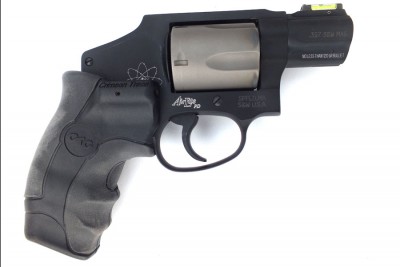
S&W CTG: The new LG-350 Crimson Trace grip with a wider rear profile and two-Surface design does a lot to tame the beast.
Enter the S&W 340 .357 Magnum
My choice for the absolute best concealed carry handgun is the Smith and Wesson 340 PD .357 Magnum with a Crimson Trace laser grip.
It’s the lightest .38 or .357 revolver made. Light weight is a premium consideration in whether people carry a gun every day and a .22 short in your hand is more effective than a double stack .45 on your dresser at home. There are those who’d argue that recoil of the .357 is beyond the ability of most untrained civilians and this is certainly a valid point, but there’s no law that requires loading .357 rounds into the 340. It shoots just fine with +P defensive .38s or even reduced recoil loads like Winchester Train and Defend defensive rounds.
No one in his or her right mind will argue that the addition of the Crimson Trace laser grip doesn’t enhance performance in low light, and remember that 70% of defensive firearms uses occurred in reduced light. I chose Crimson Trace because they’ve just brought out the perfect grip laser for the 340, their new LG-350G. It’s a green laser grip especially designed for J frame S&W in .357. It’s obvious that an 11.4 ounce .357 Magnum is going to generate considerable recoil, more than most will be comfortable with. Crimson Trace designed the LG-350 grip with a wider rear profile and two-surface design that reduces the snap of a lightweight and powerful carry gun. The broader front and rear panels are made of a softer material with a harder center section to house the batteries, laser and adjusting screws. The result is a much more comfortable recoil experience that’s manageable with .357 magnum loads and much more comfortable with lighter .38 loads.
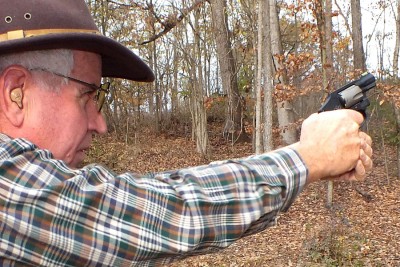
Recoil: The Airlite PD with defensive loads isn’t for the faint of heart, but you carry a defensive gun more than you shoot it. At least it doesn’t kick me into a pile of trash cans, like Will Smith’s Noisy Cricket.
There is some increase in size, but most will find it a reasonable trade-off. I compared the weight of the LG-350 and it only adds about .750 ounce over the stock grips. It brought my test gun to a total weight of just a fudge over 12 ounces, still a remarkable weight for a powerful five shot carry gun. Fully loaded with 125 grain .357s, the 340 PD weighs in at 14.5 ounces. This is five ounces less than the lightest single stack .40 and .45 semi-autos weigh empty and without a laser.
I’ve heard a lot of skepticism about laser sights and my position is that a laser sight isn’t a substitute for the sights on the gun any more than headlights are a substitute for a steering wheel on a car. Properly set, the shooter can’t even see the laser when shooting in broad daylight because the laser should be aligned to a spot just below the front sight and not visible with a proper slight picture. Almost all training should be done with the iron sights; the laser is to be used when light conditions don’t allow a proper sight picture.
I’ve tested many low light sight systems and I find them to be of limited use. Tritium sights can be seen in total darkness, but you can’t see your target in total darkness. With low background light, the standard three white dots work better for my eyes than Tritium. The green beam of the LG-350 is strongly visible in both darkness and broad daylight, but I believe in training with iron sights and the Hi-vis front and rectangular notch rear sights on the 340-PD are more than adequate for a carry gun.
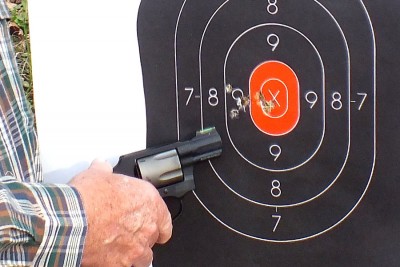 Although the vast majority of defensive encounters occur at less than three yards, I wanted to see just how accurate the .340 PD could be at longer ranges. I have in the past fired a five shot, three inch group with my S&W 637 at 25 yards using a Crimson Trace LG 105 grip in low light and ragged hole five-shot groups at seven yards are easy in deliberate fire from standing.
Although the vast majority of defensive encounters occur at less than three yards, I wanted to see just how accurate the .340 PD could be at longer ranges. I have in the past fired a five shot, three inch group with my S&W 637 at 25 yards using a Crimson Trace LG 105 grip in low light and ragged hole five-shot groups at seven yards are easy in deliberate fire from standing.
Shooting the 340 PD isn’t an exercise for the faint of heart, but it is possible to manage fast follow up shots provided you grip the gun as you should. The larger LG-350 profile and stickier grip surface on the front and rear panels enhances follow up shots over the stock rubber grips supplied on the gun. From my carry position, I can get off an A zone shot at five yards in about 2 seconds. This is a slow draw for competition, but competition holsters are a lot different from concealed carry conditions. I can empty the gun in the A Zone on a USPSA target in about six seconds. Again, poor times for a competitive shooter, but faster than I can do the same drill with my Springfield Armory XDs .45. Neither gun invites a lot of successive tries.
There are those who argue the .357 in a two inch barrel is all blast and no more effective than a .38 +P. It’s true that the difference is only a hundred feet per second or so, but that’s a more than 10% difference and, as mentioned before, you can load any .38 into the cylinder of the 340PD. It’s still the lightest thing you can find. Referring to the observations I gathered from researching the book, more power stops better.
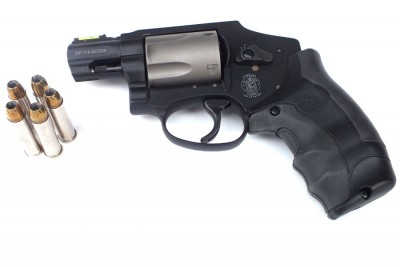
Five Rounds: Lots of horsepower, not a lot of capacity. The average number of rounds fired in a defensive engagement is under three and that average is driven up by the number of individuals who shoot to slide lock or an empty chamber.
Carrying the S&W
The best concealed carry choice in the world is of no benefit unless you have it with you and I carry every day. Last year, I carried 354 days. I was in Italy four days and New York the rest. I appendix carry in a modified Sticky Holster sewn to a Sticky Phone Taco. My previous daily carry gun was the S&W 340 M&P–a similar gun, but with a steel cylinder as opposed to the titanium cylinder of the PD. The difference in weight is just two ounces, yet it’s a noticeable instantly and really noticeable by the end of a busy day. I’ve carried a heavier gun before, and after carrying a lighter gun, a 20 ounce gun feels like a boat anchor on your beltline.
I’m not naïve enough to think for a moment that after reading this article everyone will rush out to purchase a 340PD and place their order for an LG-350 laser. In fact, the S&W website shows the 340 PD out of current production. Of course, the 340 M&P is still in current production and available, and there are those who’d argue it’s a better gun with two more ounces of recoil eating weight. Many will scoff at my choice, and just like those hairy guys around the fire eons ago, I’ll scoff at their choice. Still I’m perfectly happy to have a little Noisy Cricket tucked under my belt.
Buy one on GunsAmerica: https://www.gunsamerica.com/Search.aspx?T=340pd
